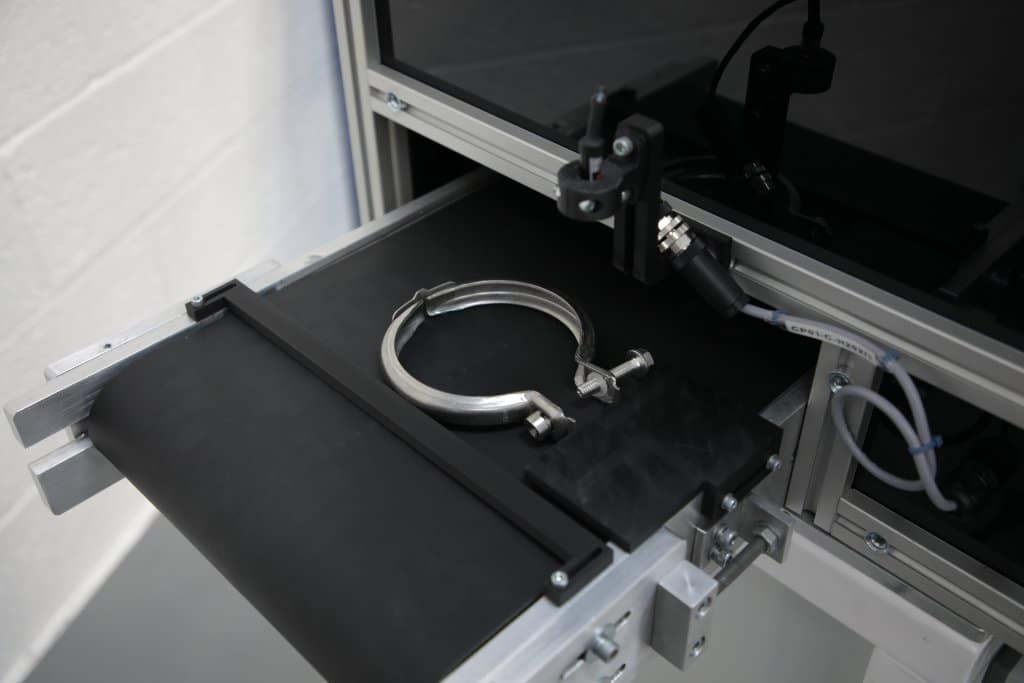Stand alone inspection system
User Requirement
Norma Group, a global manufacturing company who specialise in machine joining components, approached us to design and build a stand-alone vision inspection system intended to be interfaced to one of their current production machines. It was important that the system would have the ability to be relocated around the workplace in order to utilise it’s inspection ability on various production lines.
One of Norma’s main priorities was to ensure that any faulty profile clamps would be intercepted before leaving the factory; requiring the machine to inspect seven aspects of the profile clamp. Additionally, it was imperative that the current cycle time of the existing production machine was not significantly altered by this additional element to the process.


The Solution
As experts in vision technology and integration, we took all of Norma’s requirements into consideration and a solution was created in which; four 2D vision Picocams from SICK (uk) Ltd paired with their SIM4000 processing unit were used to inspect the nine individual aspects of the profile clamp. Thus, enabling our engineers to design a compact and easily portable vision inspection system. It was important that the new vision inspection machine was fully integrated with Norma’s existing process, but at the same time could be shut down independently without causing any major disruption to production.
The cameras were enclosed in a bespoke blackout frame coupled with a conveyor to allow repeatable inspection by blocking ambient light, and coupled with a solid infeed jig, precise placement of parts within the inspection zone. Internally one camera was mounted on a linear slide to allow adjustments of the focal position for different product sizes. A custom lighting controller was used to control this and allow multiple lighting configurations dependent on each inspection. This worked especially well for detecting and matching markings on indivisual areas specifically being inspected in relevant lighting areas within the machine. Coloured lights were used where necessary, to give clear images of the part being measured.
To inspect a part the operator manually places the profile clamp on an infeed jig on the conveyor and presses a start button. The machine conveyor moves and inspects the band automatically thus providing the operator the freedom to carry on operating the adjacent machine which is producing the next part for inspection. The stand-alone inspection machine runs in parallel with the current manufacturing process to reduce impact on part cycle time. The combination of the various vision components, allows the system to inspect different areas of the profile clamps in an efficient manner, concluding within 3 seconds if they are faulty and in retrospect of its findings, feeding the checked part either back towards the operator, if correct, or away into a reject area.
The parameters for inspection are fully customisable by the engineers and are set into a recipe system that relates to the different parts that they make. This allows quick and easy configuration either via a link to their own machine for automatic setup, or a mounted HMI screen that allows standalone operation.
The Result
After thorough in-house testing installation of the stand-alone vision inspection system was achieved in one day. Support regarding the new system was provided to Norma’s operators throughout the commissioning stage of the project. We worked closely with the members of staff focused on quality to ensure tolerances were kept to as the machine was adjected to reflect the environment in situ. This opened up discussions for further adjustments to the current procedure setup in the future.
Once in place, the stand-alone vision inspection machine very quickly helped highlight areas of improvement for the quality of parts being produced. Over a single shift zero bad parts were found to get through the machine, with an inspection rate of 99%. The machine give minimal false positives and had a minimal impact on cycle times. After running the machine over a trial period, it was concluded that the infeed jig and inspection of bands was a success.
